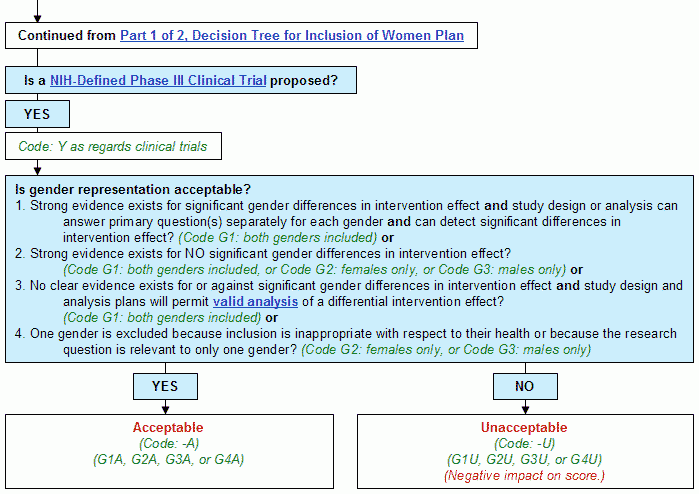Table of Contents
See the main index of Decision Trees or Research Using Human Subjects.
Graphical Flowchart
Continued from Decision Tree for Inclusion of Women Plan, Part 1 of 2.

Credit:
NIAID
Text Version of Flowchart
Continued from Decision Tree for Inclusion of Women Plan, Part 1 of 2.
Step 1. Is a NIH-defined phase III clinical trial proposed?
- If no, return to Decision Tree for Inclusion of Women Plan, Part 1 of 2 .
- If yes:
- Human Subjects Code: Y as regards clinical trials.
- Continue to Step 2.
- Is gender representation acceptable?
- Strong evidence exists for significant gender differences in intervention effect and study design or analysis can answer primary question(s) separately for each gender and can detect significant differences in intervention effect? (Code G1: both genders included) or
- Strong evidence exists for NO significant gender differences in intervention effect? (Code G1: both genders included, or Code G2: females only, or Code G3: males only) or
- No clear evidence exists for or against significant gender differences in intervention effect and study design and analysis plans will permit valid analysis of a differential intervention effect? (Code G1: both genders included) or
- One gender is excluded because inclusion is inappropriate with respect to their health or because the research question is relevant to only one gender? (Code G2: females only, or Code G3: males only)
- If yes:
- Acceptable.
- Code G1A, G2A, G3A, or G4A.
- End.
- If no:
- Unacceptable.
- Code G1U, G2U, G3U, or G4U.
- Negative impact on score.
- End.
Summary of Codes
| Gender Representation | Representation is scientifically... | |
|---|---|---|
| Acceptable | Unacceptable (bar to award) | |
| Both genders included | G1A | G1U |
| Females only | G2A | G2U |
| Males only | G3A | G3U |
| Unknown (cannot be known) | G4A | G4U |
Clinical Trial Status
- X—Human subjects not involved (not clinical research)
- N—Clinical research, not an NIH-defined Phase III clinical trial
- Y—Clinical research, an NIH-defined Phase III clinical trial

